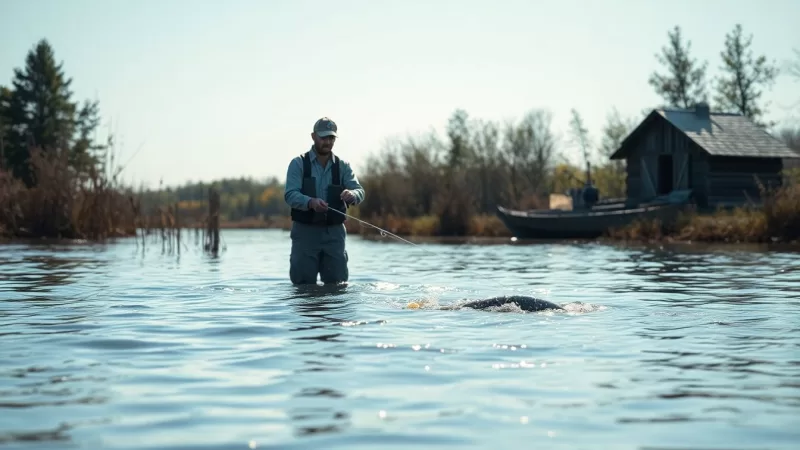American Eel Fishing in Massachusetts

Ever hooked something that felt like a wet, electric noodle? That could’ve been an American eel! Angling for eels in Massachusetts brings a unique challenge. It’s rewarding for both new anglers and old pros. These slippery fish play a big role in the state’s waters. Get ready to learn how to catch them!
Understanding the American Eel in Massachusetts
Eels have a wild life story. They hatch far away. Then, they swim to our rivers and streams. They live here for years. Let’s dive into what makes these eels special in Massachusetts.
Eel Biology and Life Cycle
American eels are catadromous. This means they live in fresh water but breed in the ocean. They all start in the Sargasso Sea. Baby eels, called glass eels, then travel thousands of miles. They arrive in Massachusetts waters. They grow into adults. Eel growth rates vary. Most eels in Massachusetts are a good size.
Habitat and Distribution in Massachusetts
Eels aren’t picky. You can find them in rivers, streams, and even the ocean. They like places with mud or sand. Look for them in ponds too. Some great spots in Massachusetts include the Charles River. Also try the Taunton River. Don’t forget the Ipswich River!
Conservation Status and Regulations
Eels face some challenges. Their numbers aren’t what they used to be. So, Massachusetts has rules. These rules help to protect them. Check with the Massachusetts Division of Fisheries and Wildlife before you fish. Make sure you know the current laws.
Essential Gear and Tackle for Eel Fishing
Having the right gear is key to catch eels. You’ll need a good rod, reel, and some strong line. Don’t forget hooks and bait! Here’s what you need to know.
Rods, Reels, and Lines
Spinning rods are a great choice for eel fishing. Baitcasting rods work well too. Pick a rod that’s medium-heavy. This will handle the eel’s strength. Use a line that’s at least 10-pound test. Braided line offers good sensitivity.
Hooks, Weights, and Rigs
Circle hooks work great for eels. Size 2/0 or 3/0 is a good starting point. Use enough weight to hold your bait on the bottom. A Carolina rig is a popular choice. A three-way swivel rig works too.
Bait Selection for Massachusetts Eels
Eels love smelly baits. Worms are always a good bet. Cut fish works well too. Try using squid or even chicken liver. Rig your bait so it stays on the hook. Make sure the hook point is exposed.
Prime Locations for Eel Fishing in Massachusetts
Massachusetts has many places to catch eels. Rivers, coastal areas, and ponds all hold eels. Find the best spots and get ready to fish!
River and Stream Hotspots
The Charles River offers good eel fishing. So does the Taunton River. The Ipswich River is another option. Look for areas with deep holes and structure. Access points vary, so do some exploring!
Coastal and Estuarine Areas
Boston Harbor is a great place to fish for eels. Buzzards Bay also holds plenty of them. Cape Cod has many spots to try. Pay attention to the tides. Eels often feed more when the tide is moving.
Pond and Lake Fishing for Eels
Some ponds and lakes have good eel populations. Look for areas with weeds and submerged cover. Focus on areas near the bottom. Use your fish finder to locate structure.
Effective Techniques for Catching Eels
Eel fishing requires some patience. Bottom fishing is a common technique. Night fishing can be very effective. Learn how to present your bait right.
Bottom Fishing Methods
Cast your bait out and let it sink to the bottom. Wait for a bite. Eels often nibble before they take the bait. When you feel a pull, set the hook! Keep steady pressure on the eel as you reel it in.
Night Fishing Strategies
Eels are more active at night. Use a black light to see your line. Some anglers use lighted bobbers. Try using scent attractants. These can help draw eels in.
Live Bait Presentation Tips
Live bait can be deadly for eels. Hook the bait through the lips or tail. Use a slow retrieval. Let the eel find the bait. Be ready for a quick strike!
Responsible Eel Fishing Practices
We need to protect our eel populations. Catch and release is a good option. Know the regulations. Minimize your impact on the environment.
Catch and Release Guidelines
Handle eels gently if you plan to release them. Use wet hands. This helps protect their slime coat. Try to remove the hook quickly. Barbless hooks make this easier.
Understanding and Following Regulations
Always check the current Massachusetts fishing regulations. You can find them on the state’s website. Pay attention to size limits and bag limits. Respect closed seasons.
Minimizing Environmental Impact
Pack out all your trash. Don’t leave fishing line behind. Avoid disturbing sensitive habitats. Stay on marked trails. Be a good steward of the environment.
Conclusion
American eel fishing in Massachusetts is a unique experience. It offers challenges and rewards. Knowing the eel’s biology is key. Use the right gear and techniques. Always fish responsibly. Explore the many great spots in Massachusetts. Enjoy the thrill of catching these amazing fish!

